Damage Assessment in Rural Environments Following Natural Disasters Using Multi-Sensor Remote Sensing Data
Abstract
1. Introduction
2. Materials and Methods
2.1. Methodology
2.2. Data Acquisition and Processing
2.3. Sulawesi Earthquake Analysis
3. Results and Discussion
4. Conclusions
Author Contributions
Funding
Data Availability Statement
Conflicts of Interest
Appendix A
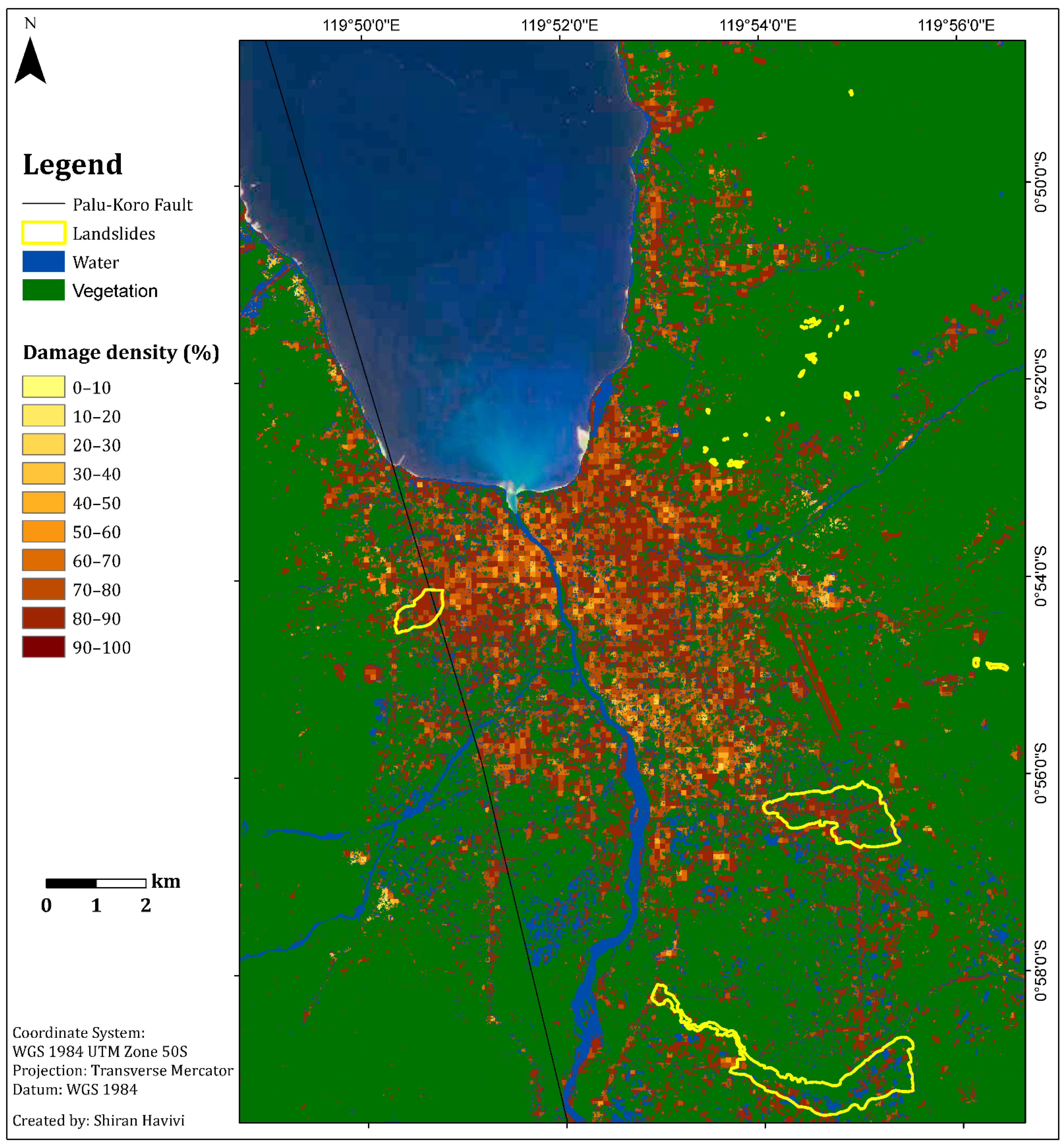
References
- Havivi, S.; Schvartzman, I.; Maman, S.; Rotman, S.R.; Blumberg, D.G. Combining TerraSAR-X and Landsat Images for Emergency Response in Urban Environments. Remote Sens. 2018, 10, 802. [Google Scholar] [CrossRef]
- Plank, S. Rapid Damage Assessment by Means of Multi-Temporal SAR—A Comprehensive Review and Outlook to Sentinel-1. Remote Sens. 2014, 6, 4870–4906. [Google Scholar] [CrossRef]
- Dell’Acqua, F.; Gamba, P. Remote Sensing and Earthquake Damage Assessment: Experiences, Limits, and Perspectives. Proc. IEEE 2012, 100, 2876–2890. [Google Scholar] [CrossRef]
- Geller, R.J. Earthquake prediction: A critical review. Geophys. J. Int. 1997, 131, 425–450. [Google Scholar] [CrossRef]
- Hough, S.E. Predicting the Unpredictable: The Tumultuous Science of Earthquake Prediction; Princeton University Press: Princeton, NJ, USA, 2016. [Google Scholar]
- Oštir, K.; Veljanovski, T.; Podobnikar, T.; Stančič, Z. Application of Satellite Remote Sensing in Natural Hazard Management: The Mount Mangart Landslide Case Study. Int. J. Remote Sens. 2003, 24, 3983–4002. [Google Scholar] [CrossRef]
- Dong, L.; Shan, J. A comprehensive review of earthquake-induced building damage detection with remote sensing techniques. ISPRS J. Photogramm. Remote Sens. 2013, 84, 85–99. [Google Scholar] [CrossRef]
- Tamkuan, N.; Nagai, M. Fusion of Multi-Temporal Interferometric Coherence and Optical Image Data for the 2016 Kumamoto Earthquake Damage Assessment. ISPRS Int. J. Geo Inf. 2017, 6, 188. [Google Scholar] [CrossRef]
- Chen, S.-W.; Wang, X.-S.; Sato, M. Urban Damage Level Mapping Based on Scattering Mechanism Investigation Using Fully Polarimetric SAR Data for the 3.11 East Japan Earthquake. IEEE Trans. Geosci. Remote Sens. 2016, 54, 6919–6929. [Google Scholar] [CrossRef]
- Cooner, A.J.; Shao, Y.; Campbell, J.B. Detection of Urban Damage Using Remote Sensing and Machine Learning Algorithms: Revisiting the 2010 Haiti Earthquake. Remote Sens. 2016, 8, 868. [Google Scholar] [CrossRef]
- Ji, Y.; Sumantyo, J.T.S.; Chua, M.Y.; Waqar, M.M. Earthquake/Tsunami Damage Level Mapping of Urban Areas Using Full Polarimetric SAR Data. IEEE J. Sel. Top. Appl. Earth Obs. Remote Sens. 2018, 11, 2296–2309. [Google Scholar] [CrossRef]
- Chen, S.-W.; Wang, X.-S.; Xiao, S.-P. Urban Damage Level Mapping Based on Co-Polarization Coherence Pattern Using Multitemporal Polarimetric SAR Data. IEEE J. Sel. Top. Appl. Earth Obs. Remote Sens. 2018, 11, 2657–2667. [Google Scholar] [CrossRef]
- Zhang, Q.; Zhang, J.; Jiang, L.; Liu, X.; Tong, Z. Flood Disaster Risk Assessment of Rural Housings—A Case Study of Kouqian Town in China. Int. J. Environ. Res. Public Health 2014, 11, 3787–3802. [Google Scholar] [CrossRef] [PubMed]
- Stephenson, V.; Finlayson, A.; Morel, L.M. A Risk-Based Approach to Shelter Resilience following Flood and Typhoon Damage in Rural Philippines. Geosciences 2018, 8, 76. [Google Scholar] [CrossRef]
- Bhambri, R.; Mehta, M.; Dobhal, D.P.; Gupta, A.K.; Pratap, B.; Kesarwani, K.; Verma, A. Devastation in the Kedarnath (Mandakini) Valley, Garhwal Himalaya, during 16–17 June 2013: A Remote Sensing and Ground-Based Assessment. Nat. Hazards 2016, 80, 1801–1822. [Google Scholar] [CrossRef]
- Dasgupta, P.; Morton, J.F.; Dodman, D.; Karapinar, B.; Meza, F.; Rivera-Ferre, M.G.; Toure Sarr, A.; Vincent, K.E. Rural Areas Climate Change 2014: Impacts, Adaptation, and Vulnerability. Part A: Global and Sectoral Aspects. Contribution of Working Group II to the Fifth Assessment Report; Intergovernmental Panel on Climate Change, Ed.; Cambridge University Press: Cambridge, UK; New York, NY, USA, 2014; pp. 613–657. [Google Scholar]
- United Nations Department of Economic and Social Affair (UN-DESA) 68% of the World Population Projected to Live in Urban Areas by 2050, Says UN. Available online: https://www.un.org/development/desa/en/news/population/2018-revision-of-world-urbanization-prospects.html (accessed on 24 May 2022).
- Bloom, D.E.; Craig, P.H.; Malaney, P.N. The Quality of Life in Rural Asia; Asian Development Bank: Mandaluyong, Philippines, 2001. [Google Scholar]
- Mulyana, W. Rural-Urban Linkages: Indonesia Case Study; Urban and Regional Development Institute (URDI), Indonesia, Jakarta, Ed.; RIMISP: Santiago, Chile, 2014. [Google Scholar]
- Pizzoli, E.; Gong, X. How to Best Classify Rural and Urban. In Proceedings of the Ponencia Presentada en la Fourth International Conference on Agriculture Statistics, Beijing, China, 22–24 October 2007; p. 24. [Google Scholar]
- Hewitt, K. Regions of Risk: A Geographical Introduction to Disasters; Routledge: London, UK, 2014. [Google Scholar]
- Gallego, F.J. Mapping Rural/Urban Areas from Population Density Grids; Institute for Environment and Sustainability, JRC-EC: Ispra, Italy, 2008; pp. 1–19. [Google Scholar]
- Lei, J.; Wang, L.; Wang, K.; Gong, K.; Hu, J. Earthquake-resistant performance investigation for rural buildings in Zhongxiang area, China. Geod. Geodyn. 2013, 4, 55–60. [Google Scholar] [CrossRef]
- Xu, H. Modification of normalised difference water index (NDWI) to enhance open water features in remotely sensed imagery. Int. J. Remote Sens. 2006, 27, 3025–3033. [Google Scholar] [CrossRef]
- Havivi, S.; Amir, D.; Schvartzman, I.; August, Y.; Maman, S.; Rotman, S.R.; Blumberg, D.G. Mapping Dune Dynamics by InSAR Coherence. Earth Surf. Process. Landf. 2018, 43, 1229–1240. [Google Scholar] [CrossRef]
- ESRI ArcGIS Desktop: Release 10.8.1; ESRI: Redlands, CA, USA, 2022.
- Patria, A.; Putra, P.S. Development of the Palu–Koro Fault in NW Palu Valley, Indonesia. Geosci. Lett. 2020, 7, 1. [Google Scholar] [CrossRef]
- Valkaniotis, S.; Ganas, A.; Tsironi, V.; Barberopoulou, A. A Preliminary Report on the M7.5 Palu Earthquake Co-Seismic Ruptures and Landslides Using Image Correlation Techniques on Optical Satellite Data; Zenodo: Genève, Switzerland, 2018. [Google Scholar]
- Socquet, A.; Hollingsworth, J.; Pathier, E.; Bouchon, M. Evidence of supershear during the 2018 magnitude 7.5 Palu earthquake from space geodesy. Nat. Geosci. 2019, 12, 192–199. [Google Scholar] [CrossRef]
- Jaya, A.; Nishikawa, O.; Jumadil, S. Distribution and Morphology of the Surface Ruptures of the 2018 Donggala–Palu Earthquake, Central Sulawesi, Indonesia. Earth Planets Space 2019, 71, 144. [Google Scholar] [CrossRef]
- Kiyota, T.; Furuichi, H.; Hidayat, R.F.; Tada, N.; Nawir, H. Overview of long-distance flow-slide caused by the 2018 Sulawesi earthquake, Indonesia. Soils Found. 2020, 60, 722–735. [Google Scholar] [CrossRef]
- Mason, H.B.; Gallant, A.P.; Hutabarat, D.; Montgomery, J.; Reed, A.N.; Wartman, J.; Irsyam, M.; Prakoso, W.; Djarwadi, D.; Harnanto, D.; et al. Geotechnical Reconnaissance: The 28 September 2018 M7.5 Palu-Donggala, Indonesia Earthquake; Geotechnical Extreme Events Reconnaissance Association (GEER): Atlanta, GA, USA, 2019. [Google Scholar]
- Bradley, K.; Mallick, R.; Andikagumi, H.; Hubbard, J.; Meilianda, E.; Switzer, A.; Du, N.; Brocard, G.; Alfian, D.; Benazir, B.; et al. Earthquake-triggered 2018 Palu Valley landslides enabled by wet rice cultivation. Nat. Geosci. 2019, 12, 935–939. [Google Scholar] [CrossRef]
- Watkinson, I.M.; Hall, R. Impact of communal irrigation on the 2018 Palu earthquake-triggered landslides. Nat. Geosci. 2019, 12, 940–945. [Google Scholar] [CrossRef]
- Heidarzadeh, M.; Muhari, A.; Wijanarto, A.B. Insights on the Source of the 28 September 2018 Sulawesi Tsunami, Indonesia Based on Spectral Analyses and Numerical Simulations. Pure Appl. Geophys. 2018, 176, 25–43. [Google Scholar] [CrossRef]
- U.S. Geological Survey (USGS) M 7.5—70km N of Palu, Indonesia. Available online: https://earthquake.usgs.gov/earthquakes/eventpage/us1000h3p4/executive (accessed on 30 May 2020).
- Patton, J.R.; Wilson, R.; Dengler, L.; LaDuke, Y.; Miller, K. EERI Preliminary Notes on Tsunami Information and Response: Tsunami Generated by MW7.5 Sulawesi, Indonesia Earthquake on 28 September 2018; Earthquake Engineering Research Institute (EERI): Oakland, CA, USA, 2019. [Google Scholar]
- Syifa, M.; Kadavi, P.R.; Lee, C.-W. An Artificial Intelligence Application for Post-Earthquake Damage Mapping in Palu, Central Sulawesi, Indonesia. Sensors 2019, 19, 542. [Google Scholar] [CrossRef]
- Polcari, M.; Tolomei, C.; Bignami, C.; Stramondo, S. SAR and Optical Data Comparison for Detecting Co-Seismic Slip and Induced Phenomena during the 2018 Mw 7.5 Sulawesi Earthquake. Sensors 2019, 19, 3976. [Google Scholar] [CrossRef]
- National Board for Disaster Management (BNPB) of Indonesia. BNPB Gempabumi Sulawesi Tengah. Available online: https://sites.google.com/view/gempadonggala/beranda (accessed on 11 March 2020).
- Miyajima, M.; Setiawan, H.; Yoshida, M.; Ono, Y.; Kosa, K.; Oktaviana, I.S.; Martini; Irdhiani. Geotechnical damage in the 2018 Sulawesi earthquake, Indonesia. Geoenviron. Disasters 2019, 6, 6. [Google Scholar] [CrossRef]
- Adriano, B.; Xia, J.; Baier, G.; Yokoya, N.; Koshimura, S. Multi-Source Data Fusion Based on Ensemble Learning for Rapid Building Damage Mapping during the 2018 Sulawesi Earthquake and Tsunami in Palu, Indonesia. Remote Sens. 2019, 11, 886. [Google Scholar] [CrossRef]
- Paulik, R.; Gusman, A.; Williams, J.H.; Pratama, G.M.; Lin, S.-L.; Prawirabhakti, A.; Sulendra, K.; Zachari, M.Y.; Fortuna, Z.E.D.; Layuk, N.B.P.; et al. Tsunami Hazard and Built Environment Damage Observations from Palu City after the September 28 2018 Sulawesi Earthquake and Tsunami. Pure Appl. Geophys. 2019, 176, 3305–3321. [Google Scholar] [CrossRef]
- Kusumawardani, R.; Chang, M.; Upomo, T.C.; Huang, R.-C.; Fansuri, M.H.; Prayitno, G.A. Understanding of Petobo liquefaction flowslide by 2018.09.28 Palu-Donggala Indonesia earthquake based on site reconnaissance. Landslides 2021, 18, 3163–3182. [Google Scholar] [CrossRef]
- Mason, H.B.; Montgomery, J.; Gallant, A.P.; Hutabarat, D.; Reed, A.N.; Wartman, J.; Irsyam, M.; Simatupang, P.T.; Alatas, I.M.; Prakoso, W.A. East Palu Valley Flowslides Induced by the 2018 MW 7.5 Palu-Donggala Earthquake. Geomorphology 2021, 373, 107482. [Google Scholar] [CrossRef]
- Hazarika, H.; Rohit, D.; Pasha, S.M.K.; Maeda, T.; Masyhur, I.; Arsyad, A.; Nurdin, S. Large distance flow-slide at Jono-Oge due to the 2018 Sulawesi Earthquake, Indonesia. Soils Found. 2020, 61, 239–255. [Google Scholar] [CrossRef]
- Fotheringham, A.S.; Brunsdon, C.; Charlton, M. Geographically Weighted Regression: The Analysis of Spatially Varying Relationships; John Wiley & Sons: Hoboken, NJ, USA, 2003. [Google Scholar]
- Joshi, G.; Natsuaki, R.; Hirose, A. Neural-Network Fusion Processing and Inverse Mapping to Combine Multi-Sensor Satellite Data and to Analyze Significant Features. TechRxiv 2021. [Google Scholar] [CrossRef]
- Gomez-Chova, L.; Fernández-Prieto, D.; Calpe, J.; Soria, E.; Vila, J.; Camps-Valls, G. Urban monitoring using multi-temporal SAR and multi-spectral data. Pattern Recognit. Lett. 2005, 27, 234–243. [Google Scholar] [CrossRef]
- Hu, J.; Mou, L.; Schmitt, A.; Zhu, X.X. FusioNet: A two-stream convolutional neural network for urban scene classification using PolSAR and hyperspectral data. In Proceedings of the 2017 Joint Urban Remote Sensing Event (JURSE), Dubai, United Arab Emirates, 6–8 March 2017; pp. 1–4. [Google Scholar] [CrossRef]
- Roy, S.K.; Deria, A.; Hong, D.; Rasti, B.; Plaza, A.; Chanussot, J. Multimodal Fusion Transformer for Remote Sensing Image Classification. arXiv 2022, arXiv:2203.16952 2022. [Google Scholar]
- Liao, C.; Wang, J.; Xie, Q.; Baz, A.A.; Huang, X.; Shang, J.; He, Y. Synergistic Use of Multi-Temporal RADARSAT-2 and VENμS Data for Crop Classification Based on 1D Convolutional Neural Network. Remote Sens. 2020, 12, 832. [Google Scholar] [CrossRef]
- Ji, M.; Liu, L.; Du, R.; Buchroithner, M.F. A Comparative Study of Texture and Convolutional Neural Network Features for Detecting Collapsed Buildings After Earthquakes Using Pre- and Post-Event Satellite Imagery. Remote Sens. 2019, 11, 1202. [Google Scholar] [CrossRef]
- Ma, H.; Liu, Y.; Ren, Y.; Wang, D.; Yu, L.; Yu, J. Improved CNN Classification Method for Groups of Buildings Damaged by Earthquake, Based on High Resolution Remote Sensing Images. Remote Sens. 2020, 12, 260. [Google Scholar] [CrossRef]
- Shao, J.; Tang, L.; Liu, M.; Shao, G.; Sun, L.; Qiu, Q. BDD-Net: A General Protocol for Mapping Buildings Damaged by a Wide Range of Disasters Based on Satellite Imagery. Remote Sens. 2020, 12, 1670. [Google Scholar] [CrossRef]
- Bai, Y.; Mas, E.; Koshimura, S. Towards Operational Satellite-Based Damage-Mapping Using U-Net Convolutional Network: A Case Study of 2011 Tohoku Earthquake-Tsunami. Remote Sens. 2018, 10, 1626. [Google Scholar] [CrossRef]
- Adriano, B.; Yokoya, N.; Xia, J.; Miura, H.; Liu, W.; Matsuoka, M.; Koshimura, S. Learning from multimodal and multitemporal earth observation data for building damage mapping. ISPRS J. Photogramm. Remote Sens. 2021, 175, 132–143. [Google Scholar] [CrossRef]
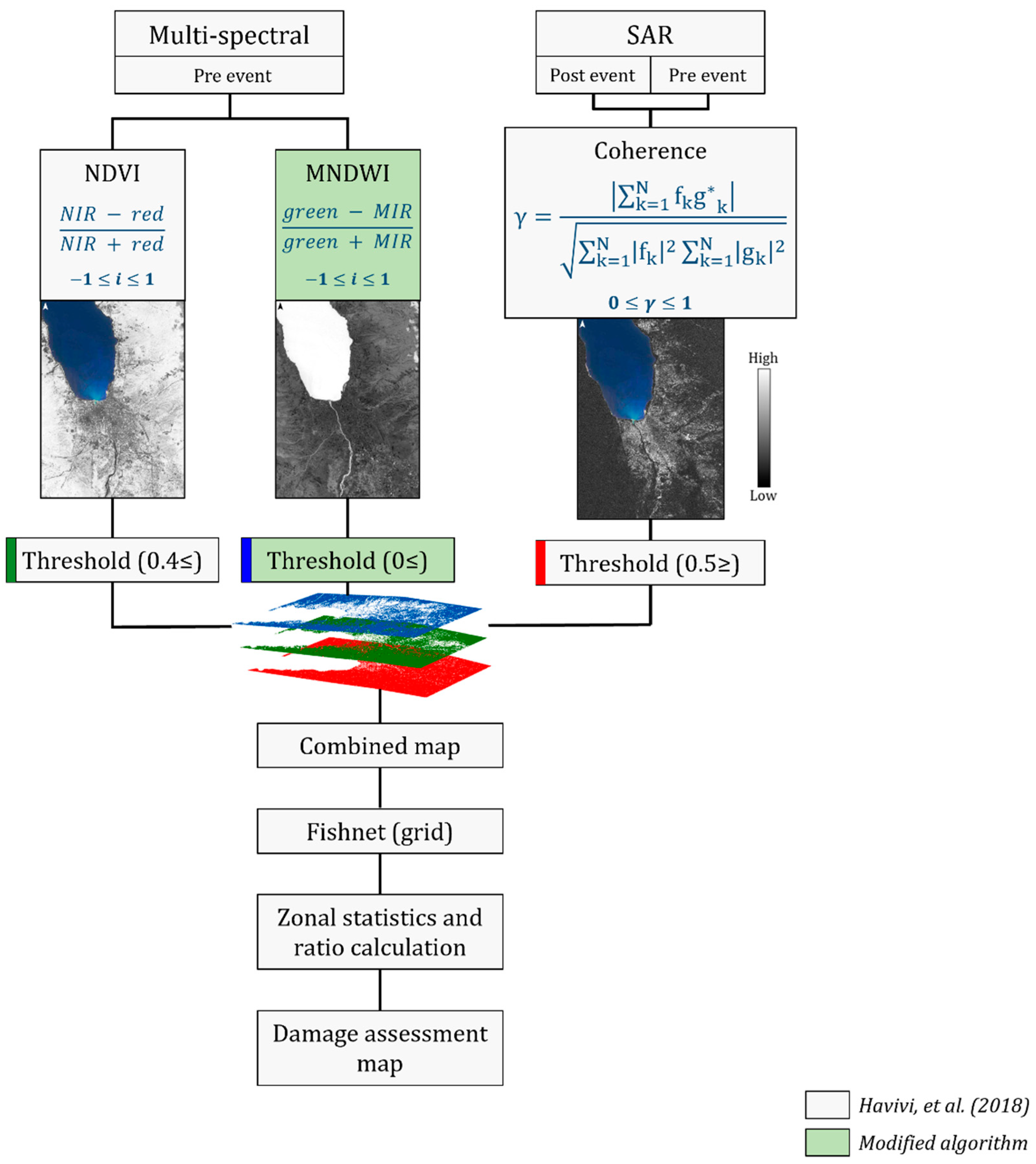
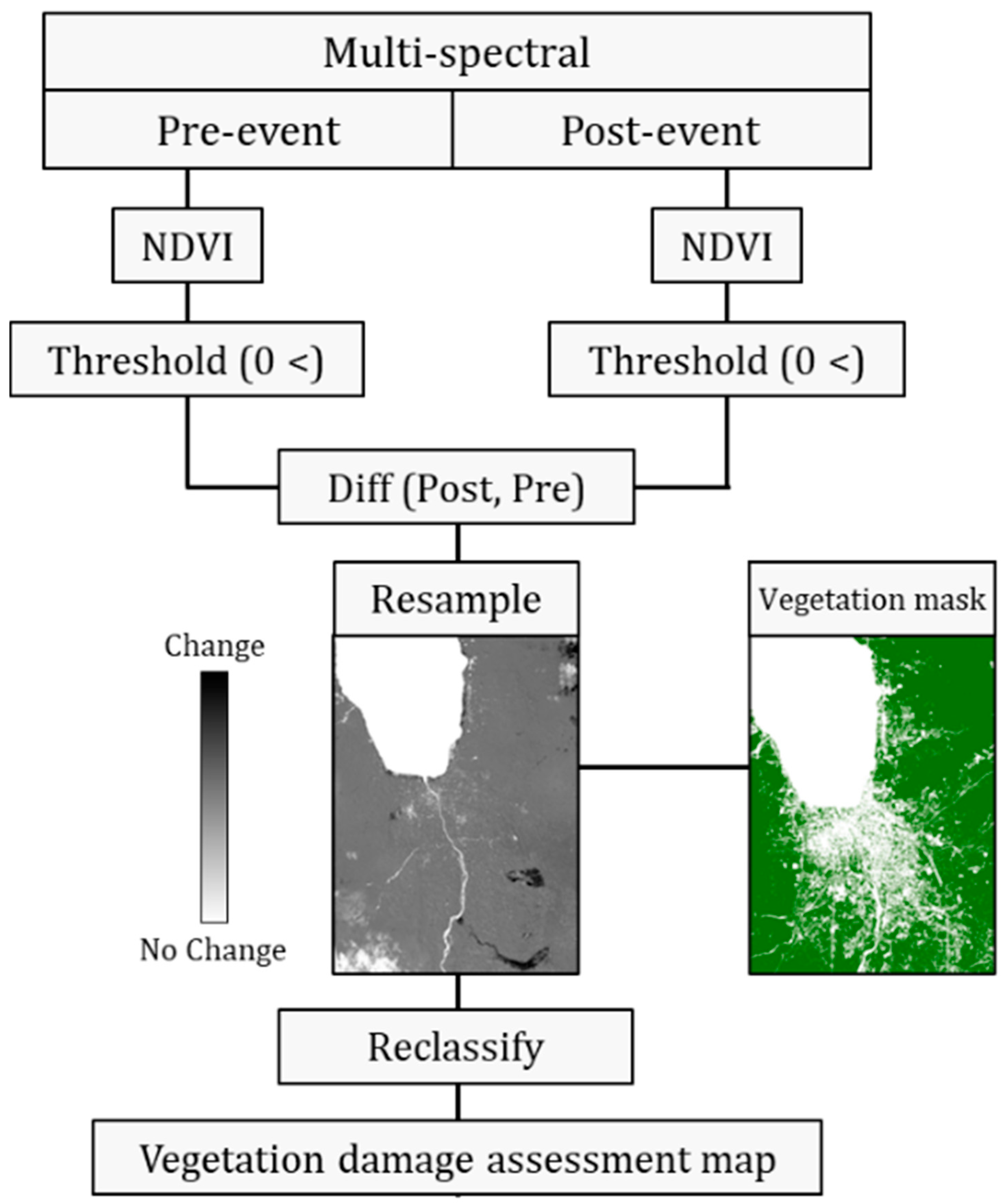
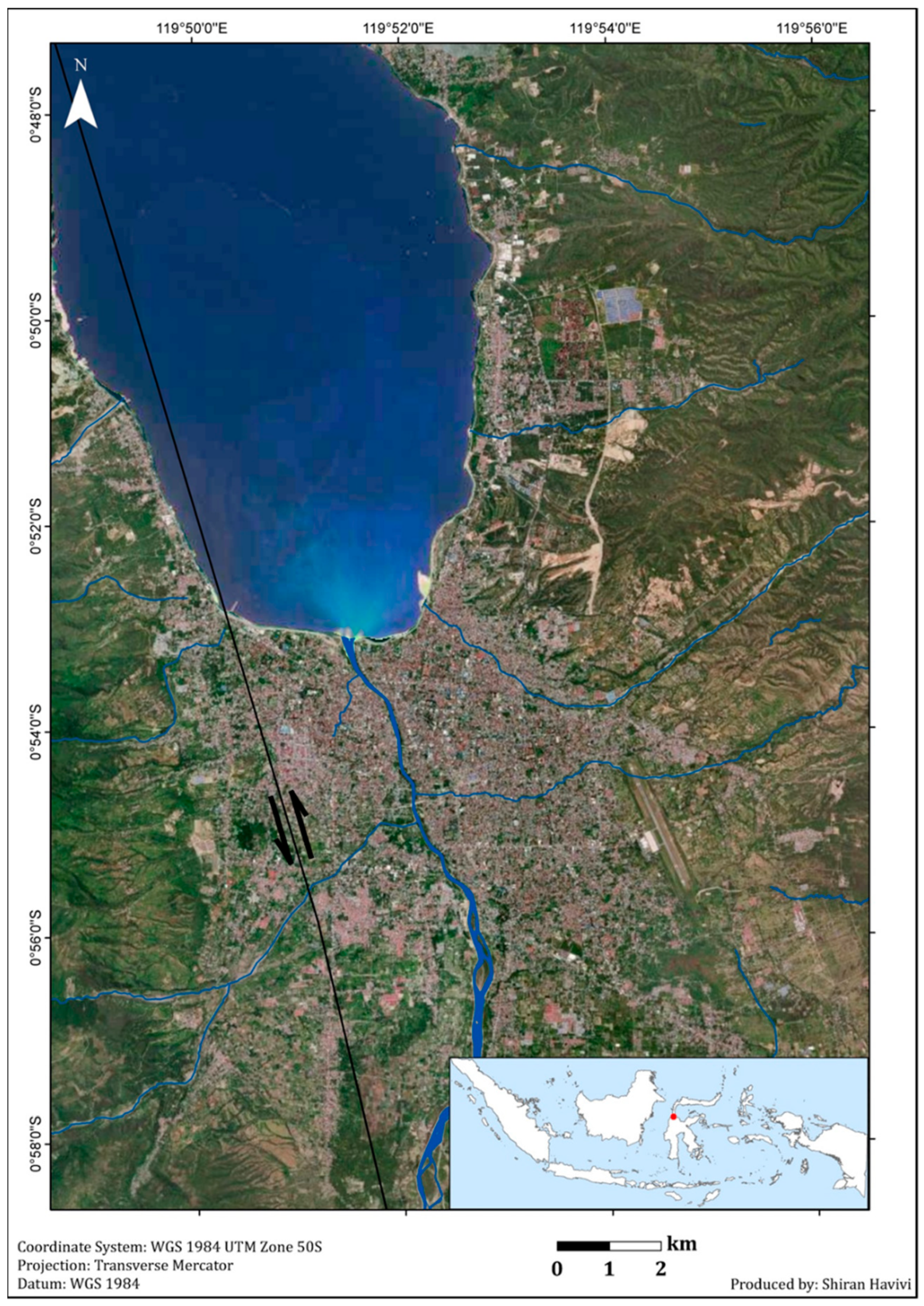
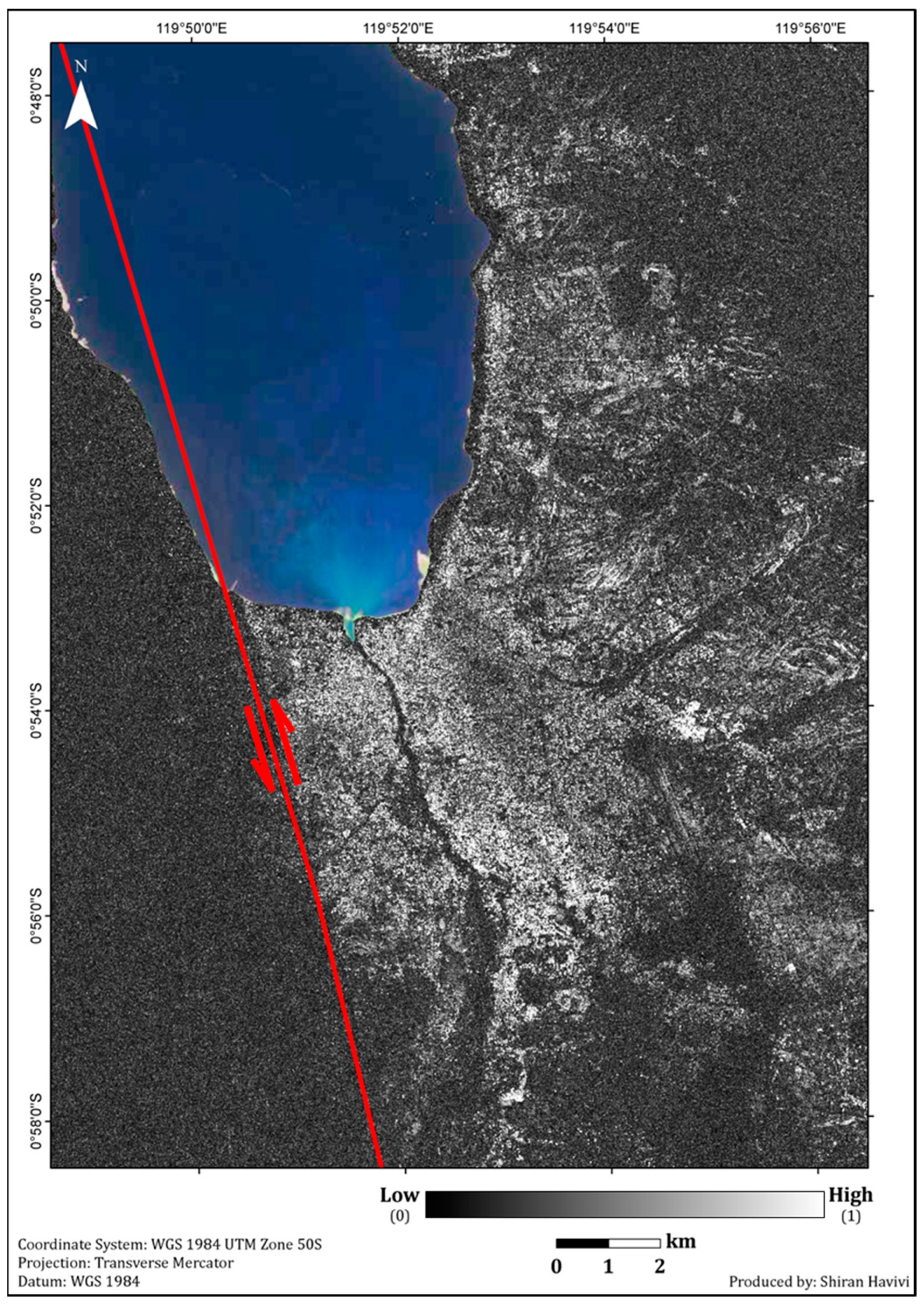
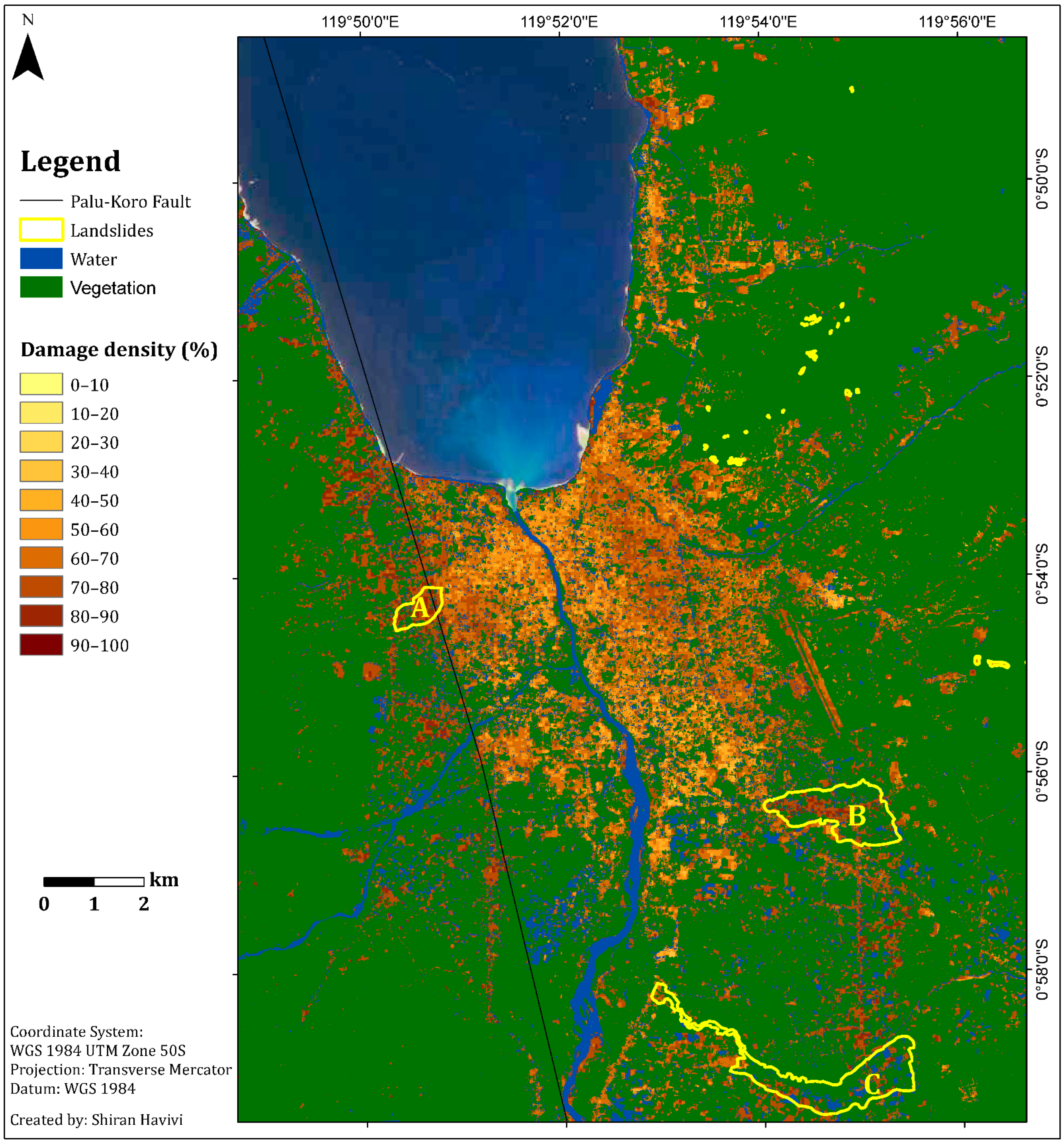
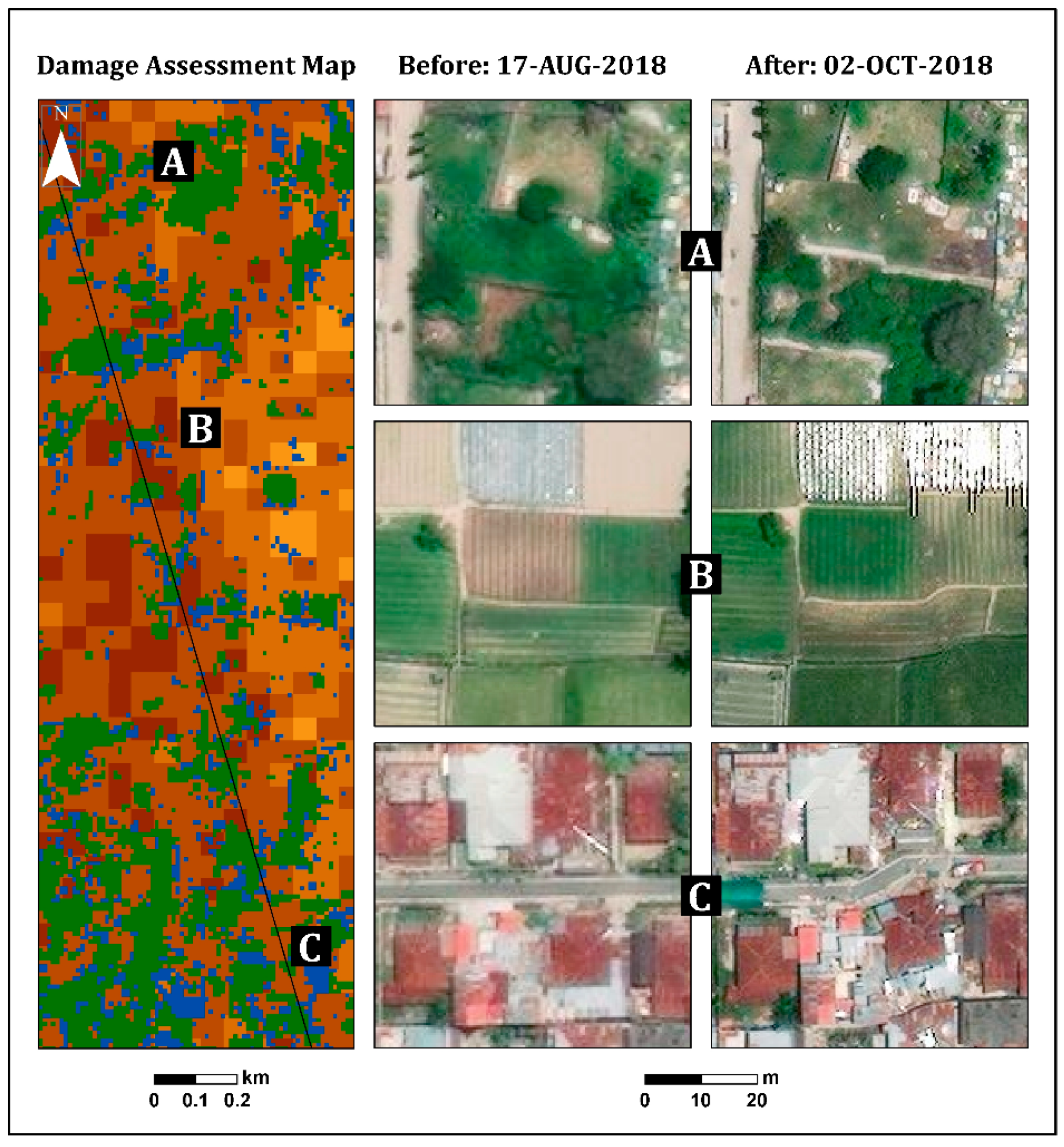
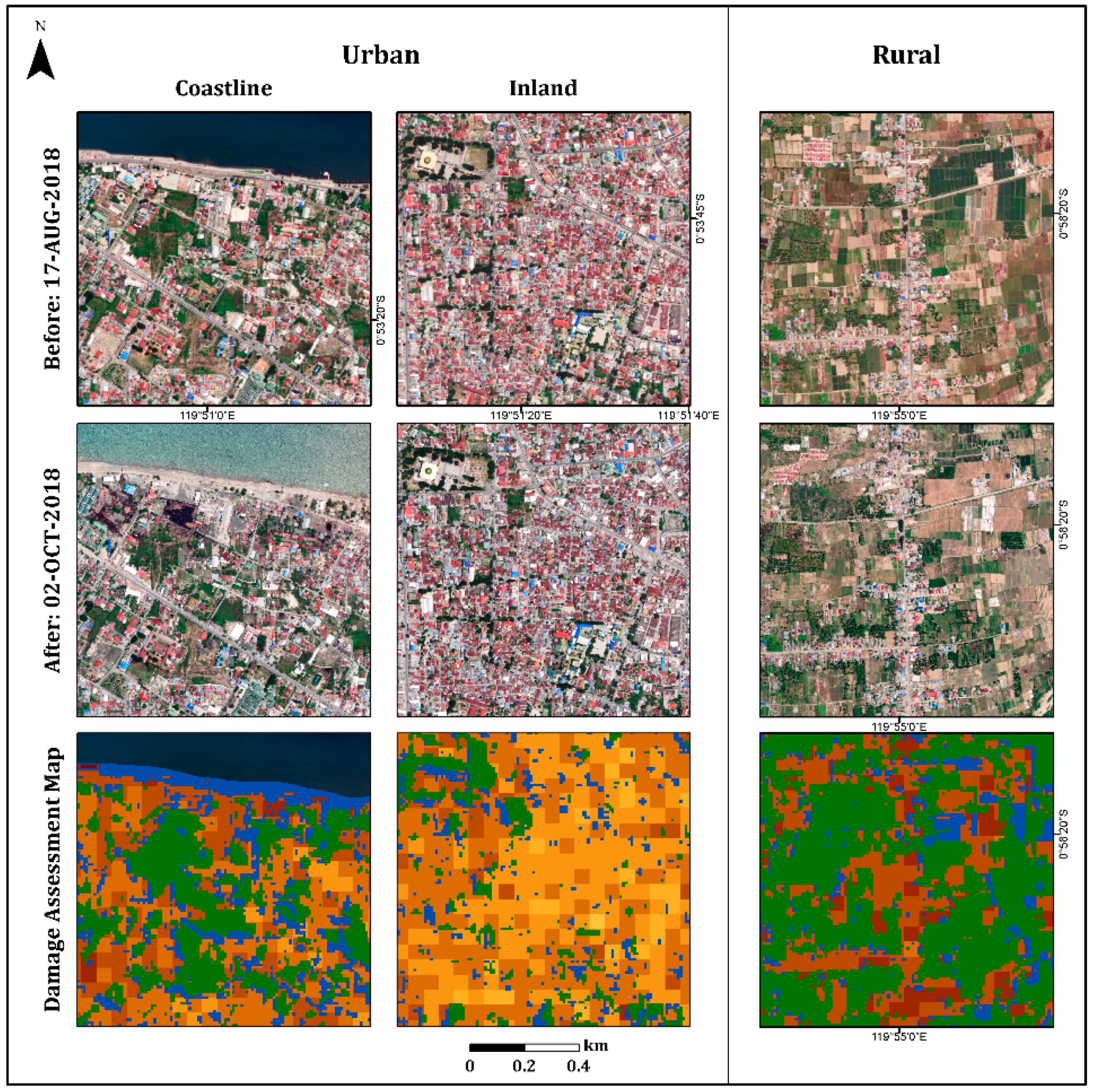


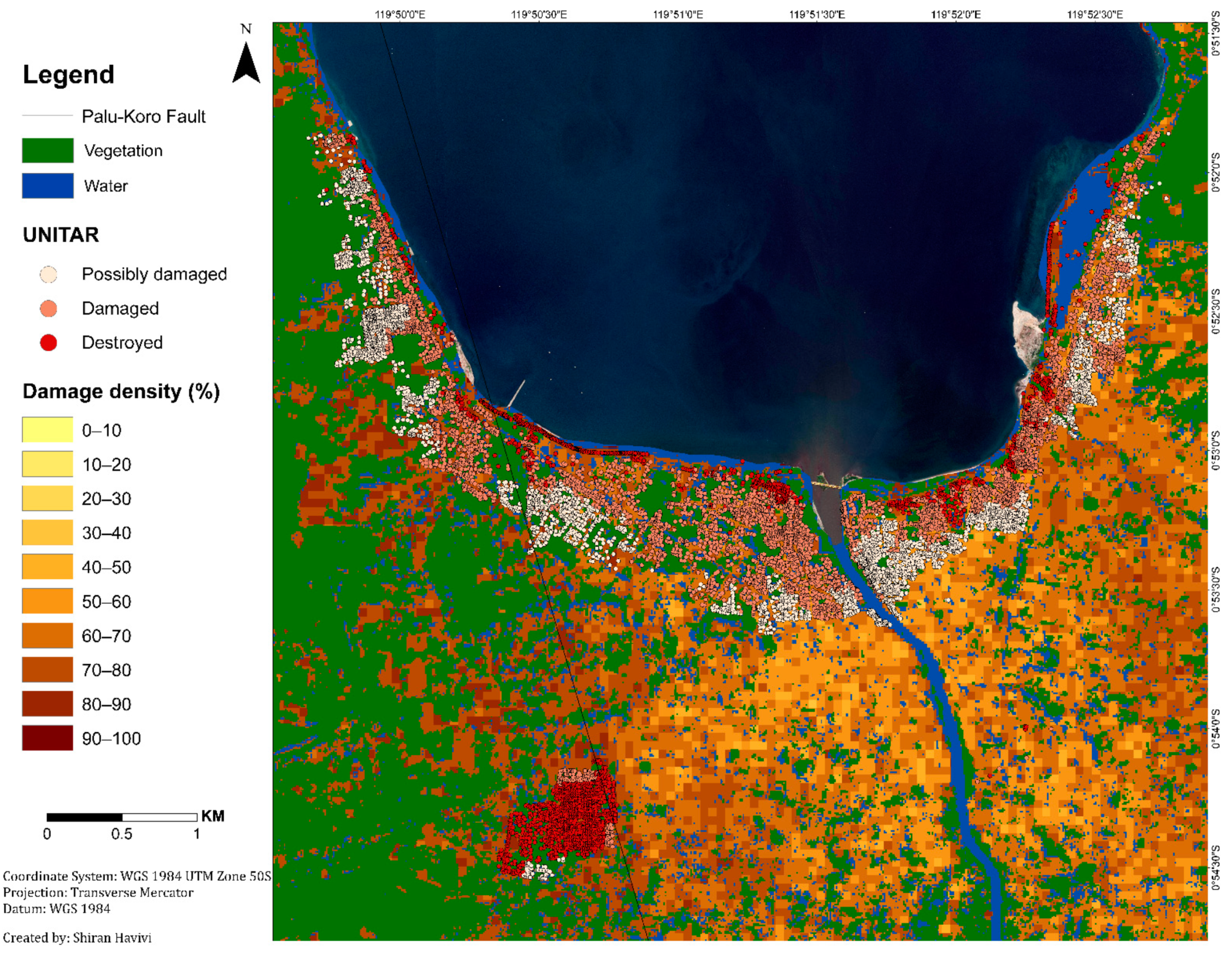



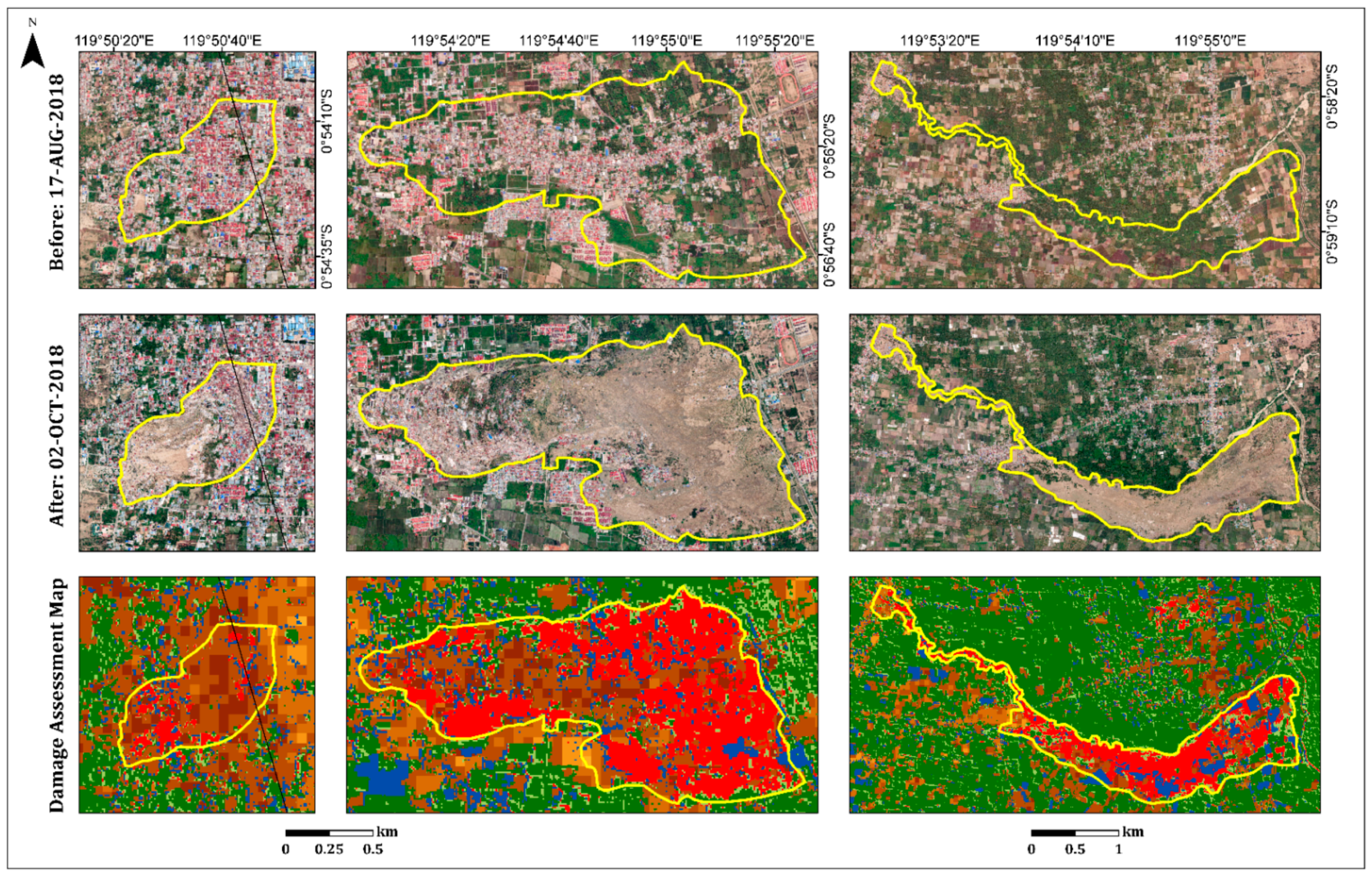
| Satellite | Sensor Type | Acquisition Date | ||
|---|---|---|---|---|
| HSR | COSMO-SkyMed | SAR | Pre-event Post-event | 23 September 2018 * 5 October 2018 |
| Sentinel-2 | Multispectral | Pre-event Post-event | 27 September 2018 2 October 2018 | |
| MSR | Sentinel-1 | SAR | Pre-event Post-event | 7 June 2018 * 5 October 2018 |
| Landsat-8 | Multispectral | Pre-event | 16 September 2018–23 September 2018 | |
| Index | Sentinel-2 | Landsat-8 | |||
|---|---|---|---|---|---|
| Band | Range (μm) | Band | Range (μm) | ||
| NDVI | Red | 4 | 0.64–0.68 | 4 | 0.64–0.67 |
| NIR | 8 | 0.76–0.90 | 5 | 0.85–0.88 | |
| MNDWI | Green | 3 | 0.53–0.58 | 3 | 0.53–0.59 |
| MIR | 11 | 1.53–1.68 | 6 | 1.57–1.65 | |
| Min | Max | Mean | Median | Std. Dev. | Skewness | Kurtosis | Majority | Minority | |
|---|---|---|---|---|---|---|---|---|---|
| Balaroa | 59.4 | 86.8 | 77.5 | 78 | 4.3 | −1.1 | 5.1 | 78 | 79.9 |
| Petobo | 48.2 | 87.3 | 77.1 | 77.7 | 5 | −1.5 | 8 | 78.2 | 65.6 |
| Jono Oge | 53.9 | 86.6 | 75 | 75.9 | 5.5 | −1.2 | 5.1 | 75.7 | 65.5 |
| Urban | 38.8 | 100 | 66.1 | 66.5 | 8.3 | −0.2 | 2.6 | 65.4 | 88.6 |
| Area km2 | Area% | Vegetation Damage% | ||||||
|---|---|---|---|---|---|---|---|---|
| Total | Vegetation | Vegetation | Water | Built | No Damage | Very Slight | Severe | |
| Balaroa | 0.43 | 0.09 | 21% | 7% | 72% | 11% | 18% | 70% |
| Petobo | 1.76 | 1.02 | 58% | 9% | 33% | 9% | 10% | 81% |
| Jono Oge | 2.24 | 1.53 | 68% | 15% | 17% | 16% | 18% | 66% |
Publisher’s Note: MDPI stays neutral with regard to jurisdictional claims in published maps and institutional affiliations. |
© 2022 by the authors. Licensee MDPI, Basel, Switzerland. This article is an open access article distributed under the terms and conditions of the Creative Commons Attribution (CC BY) license (https://creativecommons.org/licenses/by/4.0/).
Share and Cite
Havivi, S.; Rotman, S.R.; Blumberg, D.G.; Maman, S. Damage Assessment in Rural Environments Following Natural Disasters Using Multi-Sensor Remote Sensing Data. Sensors 2022, 22, 9998. https://doi.org/10.3390/s22249998
Havivi S, Rotman SR, Blumberg DG, Maman S. Damage Assessment in Rural Environments Following Natural Disasters Using Multi-Sensor Remote Sensing Data. Sensors. 2022; 22(24):9998. https://doi.org/10.3390/s22249998
Chicago/Turabian StyleHavivi, Shiran, Stanley R. Rotman, Dan G. Blumberg, and Shimrit Maman. 2022. "Damage Assessment in Rural Environments Following Natural Disasters Using Multi-Sensor Remote Sensing Data" Sensors 22, no. 24: 9998. https://doi.org/10.3390/s22249998
APA StyleHavivi, S., Rotman, S. R., Blumberg, D. G., & Maman, S. (2022). Damage Assessment in Rural Environments Following Natural Disasters Using Multi-Sensor Remote Sensing Data. Sensors, 22(24), 9998. https://doi.org/10.3390/s22249998






